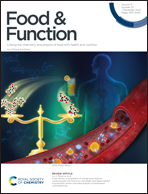Hawthorn flavonoid ameliorates cognitive deficit in mice with Alzheimer's disease by increasing the levels of Bifidobacteriales in gut microbiota and docosapentaenoic acid in serum metabolites†
Abstract
Hawthorn flavonoid (HF) exhibits potential benefits in Alzheimer's disease (AD), but its mechanism of action remains elusive. In this study, we identified the main components of HF, demonstrating that the administration of HF at a dose of 200 mg per kg per day significantly improved cognitive deficits in mice with AD induced by D-galactose and aluminum chloride. HF also effectively ameliorated β-amyloid (Aβ) accumulation and abnormal activation of hippocampal microglia. Furthermore, we investigated the effects of HF on gut microbiota and serum metabolomics in AD mice by 16S rRNA sequencing and quadrupole time-of-flight mass spectrometry. Our results showed that HF reversed the gut microbiota disturbance and metabolic disorder in AD mice by increasing the proportions of Dubosiella, Alloprevotella, and Bifidobacterium and decreasing the proportions of Acinetobacter, as well as increasing the levels of docosapentaenoic acid (DPA), sphingolipid (SM), and phosphatidylcholine (PC). Notably, a positive correlation between DPA and Bifidobacterium was observed for the first time. Therefore, HF may serve as a promising dietary supplement for improving the symptoms of Alzheimer's disease.



 Please wait while we load your content...
Please wait while we load your content...